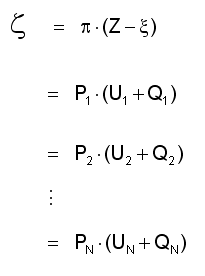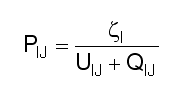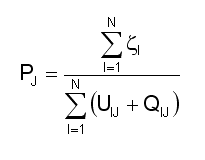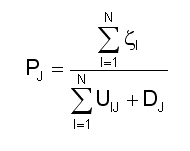As was the case when constructing a supply schedule from the notion of marginal cost, we begin construction of our demand schedules with the observation that values of marginal product are ratios of a financial quantity to a physical quantity. Once again, SFEcon’s hyperbolic system of reference suggests the financial discriminant z $/year as the proper numerator for this ratio. And, again, the primary indicator of an economic sector’s financial state was first defined by Equation 2-3 in our discussion on the polynomial factoring problem:

Eqa. 2-3
In reshaping this equilibrium equation for the inference of values of marginal product, we identify the acquisition price PJ of a sector I’s productive asset J with its marginal value PIJ in production at its optimal rate of input QIJ. As derived from Equation 2-3, the marginal value of input J to sector I is given by:

Our further supposition is that good J’s price PJ derives from some definition of the central equality among marginal values PIJ for all sectors I using good J. The first definition to be tested in this regard should of course be the simplest.
Current estimates regarding various aspects of price are required at several points in Model 0’s algorithm; and these estimates require calculation of a central tendency among ratios that are convergent toward some unified value that is not yet known with precision. Deriving a demand schedule from the ratios of financial flows to physical flows in our marginal value equations instantiates this problem. We have named our solution ‘the ratio/sum technique’ and present it at length in connection calculating the intersection of supply and demand schedules.
Presentation of the ratio/sum technique follows in direct sequence to this page. It is previewed in application to our present problem as follows: simply take the sum of all numerators in the marginal value equations, the sum of all denominators, and divide the first sum by the second:

If we then identify demand DJ with the sum on QIJ we can estimate the variation of PJ with DJ as follows:
